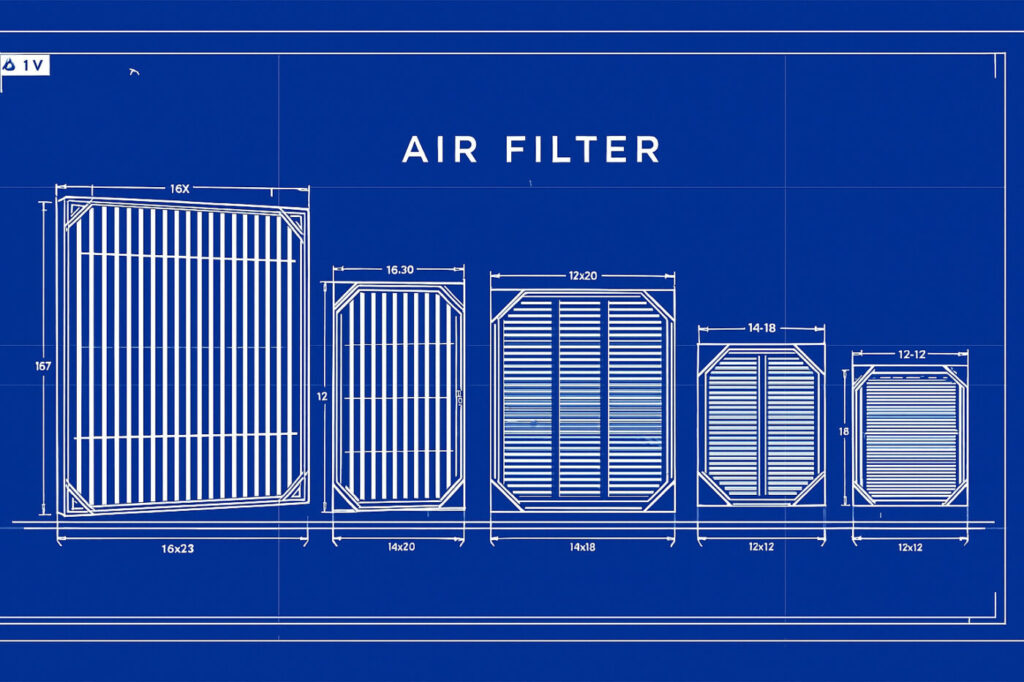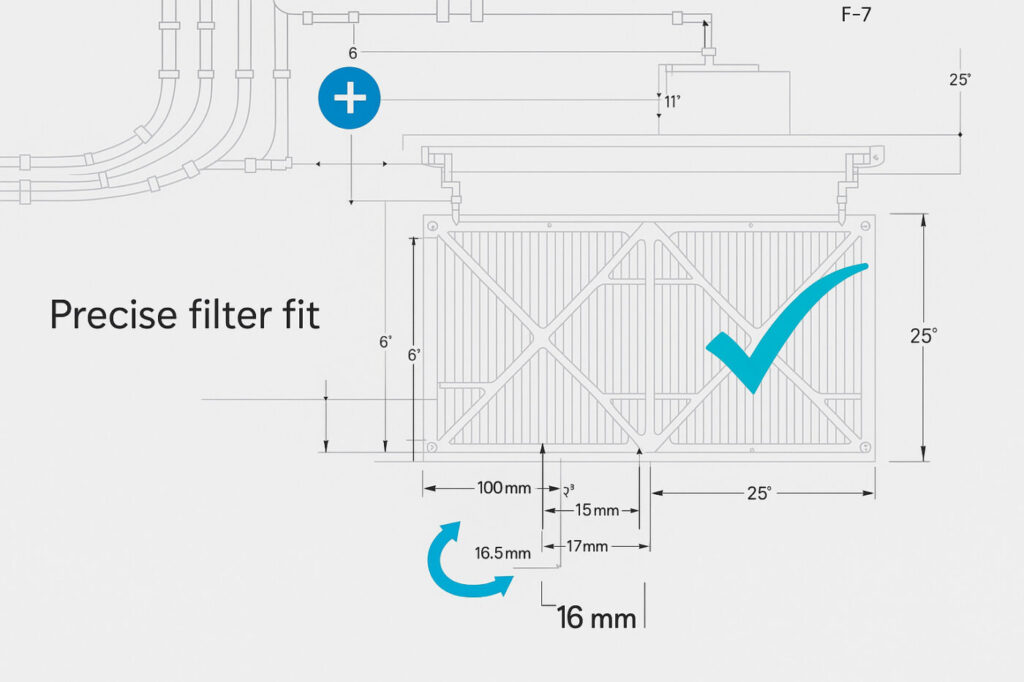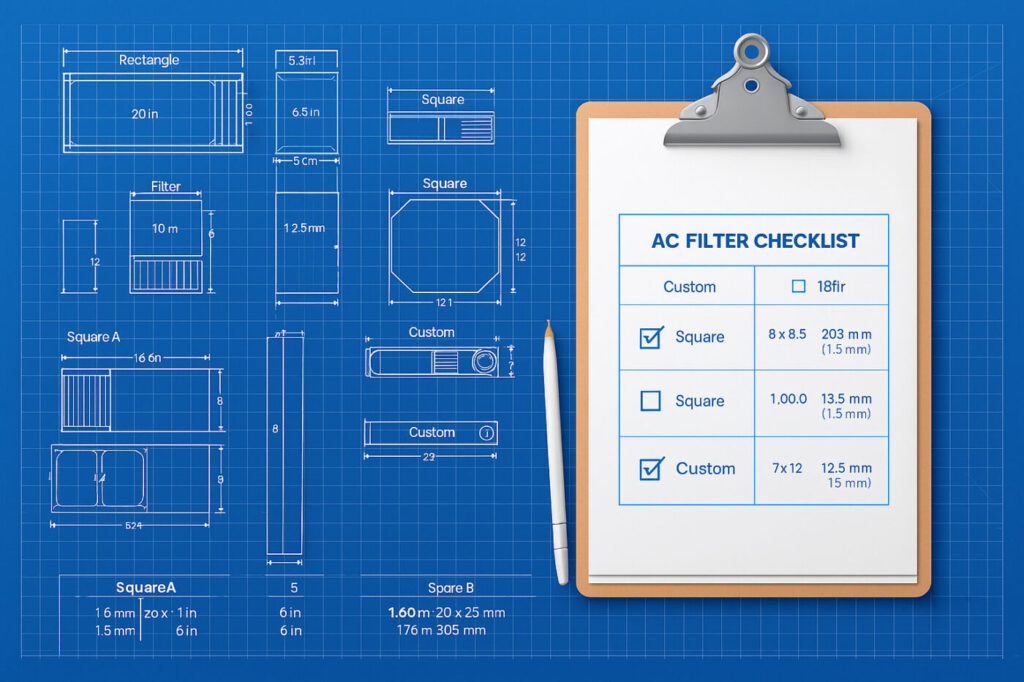
Having trouble finding the right air filter size for your HVAC system? Choosing the right size is key to efficiency and indoor air quality in your home. In this article, we’ll break down everything you need to know about air conditioner filter sizes, common dimensions, and how to measure for the perfect fit.
Quick Facts
- Choosing the right air filter size is important for HVAC efficiency and indoor air quality. Length, width and thickness are key for a proper fit.
- Standard filter sizes are 10 x 20, 14 x 20 and 20 x 30 inches, so it’s easier to find replacements.
- Regular maintenance, including timely filter changes, is crucial for optimal HVAC system performance and recommended every 60 to 90 days.
What are Air Filter Sizes

Choosing the right air filter size prevents unfiltered air from bypassing the filter and maintains system efficiency. The right size avoids putting unnecessary strain on your heating, ventilation, and air conditioning system and prevents damage over time. It’s not just about a snug fit but about the overall health of your HVAC system.
Air filters come in different sizes to fit different HVAC or engine systems. Your specific HVAC unit determines the size you need. Each filter size is indicated by:
- Length
- Width
- Thickness
These dimensions are printed on the filter frame, so it’s easy to find the right replacement.
Higher MERV (Minimum Efficiency Reporting Value) ratings offer better filtration but can restrict airflow in standard residential systems. Balancing filtration efficiency with your HVAC system’s airflow capacity is key. Understanding these basics will help you choose the right filter size, with the right MERV rating for your home.
Common Air Filter Sizes

Standard sizes
When it comes to air filters, there are several standard sizes used in most HVAC systems, including:
- 10 x 20 inches
- 14 x 20 inches
- 16 x 24 inches
- 18 x 30 inches
- 20 x 30 inches
- 24 x 24 inches
These sizes fit a wide range of units, so it’s easier to find the right replacement filters.
Other common sizes
Other common filter sizes listed below:
- 12 x 12 x 1 inches
- 14 x 14 x 1 inches
- 16 x 25 x 1 inches
- 16 x 25 x 4 inches
- 20 x 25 x 4 inches
- 20 x 25 x 1 inches
- 16 x 20 x 1 inches
- 20 x 30 x 1 inches
Knowing these common sizes will help you find an easy replacement filter, for example, at your local hardware store or online. With this info, you can choose the right filter size for your HVAC system.
Choosing the appropriate size air filter helps sustain HVAC system efficiency and improves indoor air quality. A proper fitting filter enhances system performance, keeps your home comfortable and your air clean.
How to Measure Your HVAC Air Filter Size
You can measure the correct air filter size for your HVAC system by either checking the existing filter or measuring the filter slot. Both methods have their advantages and knowing both will save you from buying the wrong size filter.
Having the right size filter maintains HVAC system efficiency, avoids unnecessary strain and ensures optimal air quality in your home. Let’s dive into the details of each method to get the perfect fit.
Checking the Existing Filter
The simplest way to find your air filter size is to check the dimensions printed on the edge of the existing filter’s frame. These dimensions usually include length, width, and thickness so that you can find a matching replacement filter at the store or online.
If the dimensions are not listed on the filter, measuring it directly is recommended. Use a tape measure to:
- Measure the length of the filter
- Measure the width of the filter
- Measure the thickness of the filter
This simple method ensures the new filter fits perfectly in your HVAC system. But if the filter is missing, you’ll need to measure the filter slot to find the right size.
Measuring the Filter Slot
If the existing air filter is not available, measuring the filter slot is the best option. Use a flat ruler or tape measure to measure the interior dimensions of the slot. This will involve measuring the length, height, and thickness of the slot to ensure the new filter fits properly. Start by listing the measurements in this order: length, width, and thickness. Make sure to keep this sequence. Round down the dimensions to the nearest inch to get the nominal size. This will help you find a filter that fits snugly without gaps and save you money.
Remember this when choosing a filter size:
- The actual height and width of the filter should be around 0.25 to 0.5 inches smaller than the slot.
- Nominal sizing can be misleading because different brands make filters with slightly different sizes.
- Accurate measurements will help you find the filter with the exact size.
Nominal vs Actual Sizes of the Filters
Knowing the difference between nominal and actual filter sizes is important when choosing an air filter. The size on the filter label is the nominal size, which may not be the actual size.
Nominal sizes are standardized dimensions for labeling, while actual sizes are the exact measurements of the filter.
Nominal sizes are rounded estimates that simplify standardized labeling for manufacturers. But the actual size air filter is what matters for a proper fit in your HVAC system. Typically, the actual size is 0.25 to 0.5 inches smaller than the nominal size.
Having the air filter size match exactly is critical
Even slight differences can affect filtration efficiency and system performance. Manufacturers use nominal sizing for easier identification and compatibility when buying filters.
Custom-made filters may have nominal sizes that round to convenient measurements while their actual sizes match specific HVAC requirements. Knowing these differences will help you make an informed decision when choosing a filter.
Why Proper HVAC Filter Fit Matters

The right air filter size improves indoor air quality and reduces energy costs. An ill-fitting filter will allow unfiltered air and contaminants to circulate indoors and compromise system performance and potentially damage it. Remember, finding the correct air filter size is key to efficient HVAC operation.
Incorrect filter sizes can cause poor airflow and negatively impact heating and cooling performance.
- Undersized filters will leave gaps and allow dust, dirt, germs and other pollutants to bypass the filter.
- Oversized filters won’t fit and will cause similar issues.
Following the manufacturer’s recommended air filter size ensures optimal system performance. Using the right size filter maintains efficient airflow, reduces strain on the HVAC system and prevents costly repairs. Regular filter changes are crucial for efficiency and air quality.
MERV Ratings and HVAC Filters

MERV ratings indicate the level of filtration efficiency.
MERV stands for Minimum Efficiency Reporting Value and depends on health conditions, local environment and HVAC system capability.
MERV ratings range from 1 to 16.
Filters rated MERV 8 to 13 balance good air quality with decent airflow and are suitable for most households. Higher MERV-rated filters can restrict airflow and may require HVAC systems to work harder. So, choosing a filter that your system can handle without compromising efficiency is key.
Individuals with respiratory conditions may benefit from HVAC filters rated MERV 10 or 12 as they are more effective at capturing allergens, mold particles and pollen, which can help with allergies and bacteria. MERV ratings above 13 are generally not needed for residential use and may require more robust HVAC equipment.
Understanding MERV ratings helps you choose filters that balance filtration and airflow for optimal indoor air quality.
Custom HVAC Air Filter Sizes
Standard air filter sizes may not be available for some HVAC units. That’s where custom air filters come in.
Custom air filters made to exact dimensions ensure a perfect fit for your unique HVAC setup.
Providers like Filterbuy offer custom sizes for air filters for HVAC systems with non-standard sizes. By choosing custom filters, you can ensure your HVAC system runs efficiently without the hassle of finding standard sizes that may not fit.
Best Practices for HVAC Filter Maintenance

Changing your HVAC filter regularly enhances indoor air quality. It also prolongs the life of your heating and cooling system.
Neglecting air filter changes can:
- reduce efficiency,
- increase energy bills,
- potentially damage the HVAC system.
Changing air filters regularly is crucial for effective filtration and overall air quality.
For optimal performance, change air filters every 90 days. Regular filter changes ensure a well-functioning HVAC system. Air filters can be replaced every 60 days if necessary, or more frequently if recommended by the manufacturer.
Homeowners should set reminders or enroll in scheduled delivery services for timely filter replacements. These tips can help you remember to change the filter in time and maintain your indoor air quality.
Conclusion
In summary, choosing the right AC air filter size is key to HVAC system efficiency and indoor air quality. By knowing common air filter sizes, determining your air filter size and understanding nominal and actual sizes, you can ensure a perfect fit for your HVAC system. Regular maintenance and choosing the right MERV rating are also important. Remember, a well-maintained HVAC system not only improves air quality but also saves on energy costs. Keep your system running smoothly by following these guidelines and enjoy a healthier indoor environment.
FAQs
To find the right air filter size for your HVAC system, check the dimensions on your current air filter or measure the filter slot if the filter is missing. Ensuring the right size is key to performance and efficiency.
The difference between nominal and actual filter sizes is in their definition. Nominal sizes are standardized labels, whereas actual sizes are the exact measurements, which are typically 0.25 to 0.5 inches smaller than the nominal air filter sizes. Understanding this is crucial for proper fitting and replacement.
It’s best to change your HVAC air filter every 60 to 90 days for optimal performance or as directed by the manufacturer. Regular maintenance ensures better efficiency and air quality in your home.
A MERV rating, or Minimum Efficiency Reporting Value, measures the effectiveness of air filters in trapping particles. It’s important to choose the right filter based on your health needs and the capability of your HVAC system.
Yes, you can get custom air filters for your HVAC system that fit your exact dimensions. Providers like Filterbuy offer various custom sizes to ensure a perfect fit for your unique setup.